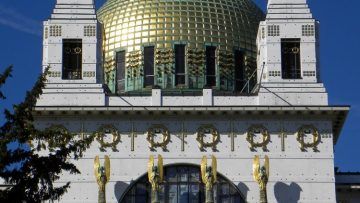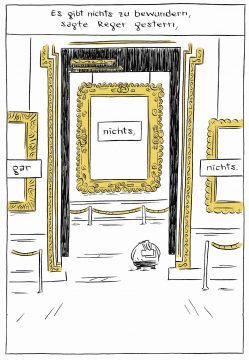by Leanne Ogasawara

Arriving in Vienna, we immediately set out for District 14, in the western suburbs of the city. Exhausted after the long journey from Los Angeles, all we wanted to do was get something to eat and crash out in our room. Unfortunately, Viennese architect Otto Wagner’s legendary church was only opened to the public for four hours a week –on Sundays from noon to 4pm. And today was Sunday, so it was now or never!
Completed in 1907, the Kirche am Steinhof is considered to be one of the the most beautiful Art Nouveau churches in the world. Located on top of a wooded hill (Ah, the Vienna Woods!), the church is part of a sprawling psychiatric hospital—once one of the largest in Europe. It is also the place where a dear friend of mine had gone on her first date with the man she fell madly in love with decades ago.
It was an odd spot for a first date. But my friend assured me: It had been perfect–and they were still going strong!
Still, I had never been on the grounds of a psychiatric hospital before. The guard stationed at the front gate inquired if we wanted to see the church: Kirche? We nodded, and he pointed up the hill. There were maybe a dozen old buildings, each set within its own grove of trees, dotting the extensive grounds. The church loomed large above the wooded landscape. Its golden dome–recently renovated– was gleaming in the brilliant sunlight. I could easily understand why the locals called it: limoniberg (the lemon hill).
The hospital grounds were a cheerful place. It was only later that I learned its terrible history.
Edith Shefferd in her book, Asperger’s Children, tells the story about how the hospital became one of the staging points for the death camps. A heartbreaking history of hospital beds emptied of children and adults deemed “untreatable” because of their ethnicity or for any so-called anti-social tendencies; this was where the now disgraced Dr. Hans Asperger did some of his dirty work. I had no idea about any of this dark history as I walked along the tree-lined path that sunny August day. All I was thinking was what a perfect setting for a novel the place would make. And sure enough, it had been just that: this picturesque and strange place was the backdrop for my now favorite novel by Austrian writer Thomas Bernhard.
 Wittgenstein’s Nephew (1982) is set over the course of several months in 1967, at a time when the hospital was comprised of two units: the pulmonary disease clinic and the psychiatric institution. The hero of the novel–named after the novelist himself– is very ill with a lung disease –as was Bernhard his entire life. Believing himself to be dying, he spends his days morbidly dwelling on his past. One day, learning that his good friend Paul Wittgenstein –nephew of the famous philosopher– has been admitted to the psychiatric wing, he decides to sneak over the fence that separates the two facilities. As he plans this subterfuge, he reminiscences about his friend’s troubled life and about the significance of their friendship.
Wittgenstein’s Nephew (1982) is set over the course of several months in 1967, at a time when the hospital was comprised of two units: the pulmonary disease clinic and the psychiatric institution. The hero of the novel–named after the novelist himself– is very ill with a lung disease –as was Bernhard his entire life. Believing himself to be dying, he spends his days morbidly dwelling on his past. One day, learning that his good friend Paul Wittgenstein –nephew of the famous philosopher– has been admitted to the psychiatric wing, he decides to sneak over the fence that separates the two facilities. As he plans this subterfuge, he reminiscences about his friend’s troubled life and about the significance of their friendship.
The novel is typical Bernhard. Like my other favorite Bernhard, Old Masters (1985), and indeed like all of his novels, there are no paragraph breaks and no chapters. Sentences come relentlessly– one after the other without end. One die-hard Bernhard fan on Goodreads, counting the opening sentences of the story “Goethe Dies” declared:
What joy. The first sentence has 140 words, the second 190, and the third 280.
German poet Michael Hofmann once famously remarked that, “Bernhard’s novels have no moving parts.” That is to say, there are no voices for different characters, and there is no plot development; just a surreal scene that unfolds in front of the reader, through the eyes of a man engaged in a long soliloquy.
In Old Masters, there is the man. There is the painting (Tintoretto’s Man with Beard). And there are two friends. Every other day, the man comes to the museum to sit in front the same picture. Of course, he looks at the picture. But he also holds court. This is where he met his wife. We don’t find this out until the very end, though. She has just died, and he is bereft. So, he continues to sit there. And holding court for his two friends, he rips apart all manner of things held dear to the Austrian people–from Heidegger to Mahler; from the Roman Catholic Church to the city of Salzburg, absolutely nothing is sacred! (And who could hate Salzburg?) Indeed, he even concludes–sitting there in what is one of the finest collections of art in the world– that there is no picture in the gallery truly worthy of our devotion. And more, there is no work of great music good enough either. (He is a music critic for the newspaper).
Nichts. Nichts. Nichts.
To catch a glimpse of just how devilishly clever Bernhard can be, you could take a look at Nicolas Mahler’s graphic novel version of Old Masters (2018). The translation by James Reidel (who also translated one of my favorite Bernhard stories, “Goethe Dies”) is very spirited, and the drawings by Nicolas Mahler bring to life what is just so entertaining about Bernhard’s writing. But I must warn you, as much as I love the graphic novel, if you only read this version you will miss the strange and unique effect that a Bernhard novel can have.
His writing is maddening, difficult and some people think totally addictive. Wading in, the reader might feel washed out to sea. Submerged in prose without paragraphs or chapters, the repetitive, musical quality of his writing, with the single authorial voice (characters are simply not differentiated by voice in his books) is hypnotic. Someone once said that reading his novels is such an ordeal that the endings can only ever come crashing down on the reader. Speaking for myself, after reading a hundred uninterrupted pages (more like a hundred-page-long paragraph) in Old Masters–after all that ranting and raving is said and done– the denouement left me in tears. His work is profoundly moving.
During his lifetime, Bernhard was much derided by his fellow Austrians for “dirtying his own nest.” This was due to his endless tirades about Austria. He simply loathed anything that stank of the old Habsburg Empire (long gone for more than fifty years). He was furious that Austria’s complicity with the Third Reich was whitewashed. He had witnessed it first-hand, after all. He had been a child during WWII- and was keenly aware of what he felt to be a conspiracy of silence (Totschweigentaktik) and was tireless in urging fellow citizens to confront their historical culpability.
But Austria is known for being hard on her native geniuses. Maybe in a way similar to Mozart or Mahler, wily Bernhard saw it all coming! And anticipating the Austrian people embracing him only after his death, he decided to have the last laugh by stipulating in his will that upon his death, none of his works could be published or performed within Austria’s borders until the copyright period ended. And sure enough just as Bernhard suspected, after he had died Austrians came to realize that an artistic giant had been in their midst. Imagine their horror to discover that his work would be inaccessible to the next generation. It would take over fifty years before this legal obstacle was cleared.
Critics have compared his writing style to that of Kafka or Beckett, but really, to read a Bernhard novel is a singular experience. His long uninterrupted and very repetitive monologues remind me of psychotherapy; as if the “talking” alone is able to uncover the underlying trauma so that the truth can be laid bare. His novel Yes is particularly interesting on this point since the hero reflects about how ugly he must appear unburdening himself in that way to his friend Moritz. And then he practically flees in horror when the character known as the Persian Woman confesses all to him. Anyone who has been in psychotherapy might suspect that there is something crass about the way we regurgitate all our troubles to an analyst and that it can take on the form of a spewing rant. But in the end, a kind of truth can be uncovered–or so the story goes! Bernhard’s relentless focus on the inner world of his characters is not surprising given that Vienna is the birthplace of Freud’s revolutionary “talking therapy.” (note 2)
 ++
++
“We are the stuff of Viennese dreams, we moderns,” says historian Robert Weldon Whalen in his book, Sacred Spring: God and the Birth of Modernism in Fin de Siecle Vienna.
Or in the words of the great Austrian writer Hermann Broch, “The city was a dream, and the emperor a dream within the dream …”
As we were told repeatedly on guided tours in Vienna, the city’s turn of the century citizens knew that the Hapsburg empire was rotten and the end was near. But not being allowed to speak directly of things political—especially of the Hapsburgs— intellectuals, artists, and writers invented new modes of thinking, seeing, and expressing, giving birth to Fin de siècle Vienna. It is hard to come up with another period of time where so many great minds lived and rubbed shoulders so closely in one city. From physicists Ludwig Boltzmann and Erwin Schrödinger to psychologists Hans Asperger and Sigmund Freud; to composers and artists, including Schoenberg, Mahler, Schnitzler, Hofmannsthal, Klimt, Kokoschka, and Egon Schiele.
Was this not Bernhard’s greatest talent of all: to stand at a critical distance from all his society held dear and question the values and preoccupations of his day? Bernhard made a career of not just dismantling but of thoroughly undermining Austrian values, trying to uncover a deeper truth. He did this in the form of “fables, polemics, irony and satire,” much as philosopher Ludwig Wittgenstein would suggest. (note 3 on Wittgenstein).
Thinking of my own country, I wonder where America’s Thomas Bernhard is? America’s conscience: Dave Eggers is the only name I came up with so far…
During the early days of the Iraq War, I listened to a general speak about how our insularity and inability to understand the rest of the world remains at the core of quagmire after quagmire. He said, we assume the rest of the world wants to be just like us and proceed accordingly again and again at our own peril. The general ended by discussing how maybe after our empire has fallen, future travelers from China or Russia, or Iceland or Peru might come to visit places like Georgia or Los Angeles in much the same way we like to travel to former lands of the Roman Empire. “Kind of like Tuscany” he said. And that wouldn’t so bad, would it? After all, the former bastion of the powerful Hapsburgs, Vienna, has been named most livable city in the world for two years running. Despite being but a faded shadow of its former glory, it has transformed itself into something beyond empire. Of course the art collections, gorgeous architecture, dazzling cafes, and quirky inhabitants are part of the package–but so are the Vienna Woods. On one of our tours, our guide pointed out that Vienna is not just livable for people but that the entire animal world is thriving IN THE CITY! Driving or even flying into the city one is amazed to see the lush green woods encircling it like a biosphere. There is an extensive animal preserve with foxes and skunks, wild boar and deer, To breath… And everywhere bees, with hives kept even on the opera house roof.
A decline into grace. Bernhard would have been pleased.
Notes on Vienna Woods and Wittgenstein
++
Books
Thomas Bernhard: Old Masters, Old Masters Graphic Novel, Wittgenstein’s Nephew, Yes, Correction, Goethe Dies
Gita Honngeger Thomas Bernhard: The Making of an Austrian
Kandel: Age of Insight
Carl Schorske: Fin-de-Siecle Vienna
Paul Hofmann: Vienna Woods
Alexander Waugh: The House of Wittgenstein: A Family at War
Wittgenstein’s Vienna
by Allan Janik, Stephen Toulmin
Asperger’s Children: The Origins of Autism in Nazi Vienna
by Edith Sheffer
And:
No less a milquetoast magazine than the Atlantic recently ran an op-ed about America as a failed state.
